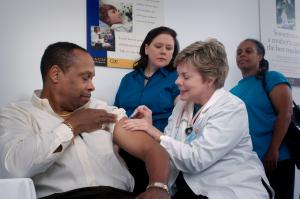- 16 reads

The healthcare industry has a sustainability problem. Globally, healthcare accounts for 4.4% of all global emissions, and at least 20% of hospital waste comes from single-use plastics. However, to provide patients with quality care, the healthcare industry needs a high energy demand and access to sanitary, single-use plastics like PPE equipment.
Clearly, heavy-handed sustainability policies would put doctors, nurses, and patients at risk. Finding the balance between sustainability and quality-of-care is difficult, but recent shortages in physicians may light the way for a future led by community-based, sustainable, healthcare programs.
Physician Shortages + Community Health Solutions
Physician shortages are affecting the entire nation. The Association of American Medical Colleges (AAMC) recently projected a shortfall of up to 139,000 physicians by 2033. This is particularly bad news as AAMC also predicts that future healthcare demands will require an increase of up to 145,500 physicians. The numbers simply don’t add up and begin to resemble something of a crisis.
However, healthcare providers are innovative and are already finding ways to maintain a high quality of care in the face of a physician shortage. Across the nation, family nurse practitioners are providing healthcare that was traditionally within the scope of physicians. This is saving patients’ lives and ensures that all communities continue to receive the care they need.
The nurse practitioner model also gives providers a guide to more sustainable practices. Nurse practitioners routinely liaise with community health programs that understand the need for sustainable practices in their communities and can make sustainability-oriented recommendations.
There are over 1,400 community health centers in the US that currently serve over 29 million patients. Community health care centers provide primary and preventative services and alleviate healthcare issues like cost, lack of insurance, and communication barriers. In their day-to-day operations, community health care centers leverage community health workers who understand the local population.
Cortlen Yarbrough, speaking to Dr. Lisa Fitzpatrick, explains that “community health workers are trusted people from the community that are able to be the bridge between the health system and the community”. He goes on to describe that community health care is all about providing at-risk or underserved communities with a personable, trustworthy connection to their healthcare. Like family nurse practitioners, community healthcare workers can fill the predicted shortfall of physicians and can create a greener tomorrow for the healthcare industry.
Sustainability + Community Health Care
Where we live matters. Recent reports have highlighted that living near areas of high emissions increases mortality rates, waste plants increase pollutants in the air we breathe, and that local governments across the nation struggle to provide the infrastructure necessary for healthy, pollutant-free, lives. Research also finds that these issues are exasperated by social inequities and environmental damage.
In the U.K., the British Medical Journal (BMJ) reports that “Where people live is perhaps the single most important determinant of their health,” and that these determinants are documented in both “high and low-income countries because of inequitable distributions of power, money, and resources.” This reality—that health is connected to environmental geopolitical factors—means that the need for effective community-based healthcare programs is higher than ever. The good news: there is already significant investment in community-based healthcare programs, and industry leaders are looking to these programs for innovative, sustainable solutions.
Community-Based Programs are Sustainability Advocates
The CDC Sustainability Planning Guide targets community-based healthcare issues and seeks to create a sustainable model for healthcare based on community healthcare programs. In their guide, the CDC emphasizes that community health workers can “help shape policy” and “create sustainable, community-based improvements that address the root of chronic diseases and risk-related factors.”
As described earlier, the root of risk-related factors for low-income populations are often pollution and unsustainable infrastructure. As such, community-based healthcare workers are positioned perfectly to advocate for sustainable policy-making, as these same policies will benefit the health of local people.
Walkable Communities and Emissions
Many of us grew up in a maze of urban sprawl that was unkind to pedestrians. However, 60% of Americans now report a desire to live in a walkable community where pedestrians are safe and can easily access services on foot. To accommodate this rise in walkable communities, municipalities must find ways to embed more healthcare options close to people’s homes via community-based healthcare programs.
This will benefit communities’ overall health and will have a positive impact on our environment. Regular walking reduces per-capita carbon emissions and can proactively reduce the need for environmentally taxing healthcare. Community-based healthcare programs which are embedded within cities and towns can help facilitate the creation of more walkable communities, which will reduce our global greenhouse gas emissions.
Smaller Business is More Agile + Sustainable
Research on greenhouse gasses has found that, since 1988, 70% of the world’s carbon emissions have been produced by just 100 companies. While most of these emissions have been produced by energy providers like Shell and BP, the reality remains that big, multinational organizations are slower to adapt and become sustainable.
This same principle applies to large, national healthcare providers who struggle to turn the helm of their operations towards sustainability. Unlike large providers, community-based healthcare programs are agile by definition. They can adapt to the demands of their local community, and have a closer connection to the root causes of patients’ illnesses. This means community-based healthcare programs can quickly take up initiatives proposed at climate conferences and by policymakers.
Community-Based Healthcare for a Greener Tomorrow
Community-based healthcare is more than a fad. It represents a significant change in the way we think about effective healthcare policy and can usher in a new era of sustainable practices. This is because community healthcare programs understand the environmental conditions their patients live in and can see the direct impact of the climate crisis on at-risk populations. Community health care workers can advocate for the interests of local populations, and increased investment into community health will reduce the unsustainable strain on hospitals.

